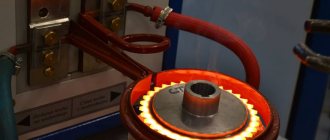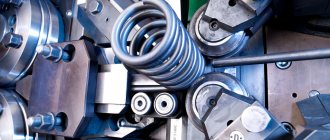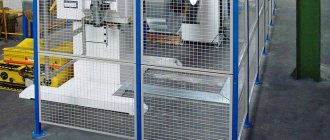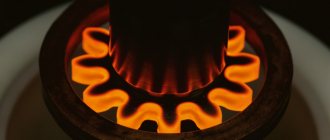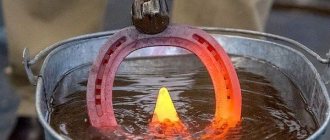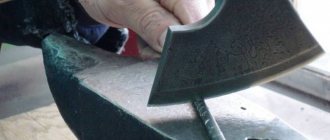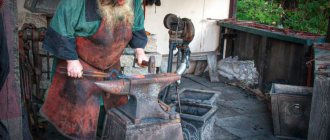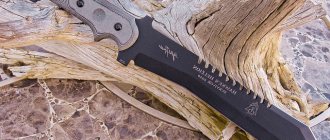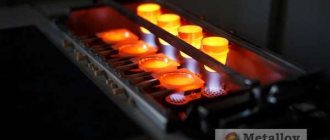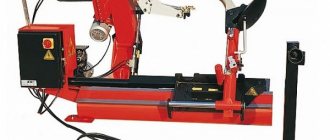Induction hardening - application, physical process, types and methods of hardening
In this article we will talk about induction hardening - one of the types of heat treatment of metals, which makes it possible for phase transformations to occur, that is, the transformation of pearlite into austenite.
Steel parts, thanks to induction hardening, acquire higher mechanical properties, because the quality of the steel increases significantly as a result of such treatment. So, for the heat treatment of metals, for the purpose of surface hardening, induction heating is used. The technology allows you to select different depths of the hardened layer, and the process is easily automated, so this method is considered progressive. It is possible to harden parts of various shapes.
Surface induction hardening is of two types: surface and volumetric-surface.
Surface hardening during surface heating leads to heating of the part to the hardening temperature to the depth of the hardened layer, while the core remains intact. The heating time is from 1.5 to 20 seconds, the heating rate is from 30 to 300 °C per second.
Volumetric-surface hardening is characterized by heating of a layer larger than the layer with a martensitic structure; this is deep heating. The steel is calcined to a shallower depth than the thickness of the heated layer, which is determined by the hardenability of the steel.
In deep areas, deeper than the martensitic structure, which are heated to the quenching temperature, strengthened zones with the structure of sorbitol or quenching troostite are formed. The hardening time increases to 20-100 seconds, the heating rate decreases to 2-10 °C per second compared to surface hardening.
Volume-surface hardening is applied to heavily loaded axles, gears, crosspieces, etc. The main difference between induction heating and other heating methods is the release of heat directly inside the volume of the part.
Basically the process goes as follows. The part to be hardened is placed in the inductor, which is powered by alternating current. An alternating magnetic field induces an EMF in the surface layer of the part, and eddy currents arise that heat the part. Those areas that are affected by an alternating magnetic field heat up to a high temperature.
The heating rate is high and local heating is possible. The current density is greater at the surface of the part due to the surface effect, so heating is possible only to the required depth. The core heats up slightly. 87% of the power transferred by eddy currents to a part occurs at the penetration depth.
Since the depth of current penetration is different at different metal temperatures, the process occurs in several stages. First of all, the surface layer of cold metal quickly warms up, then the deeper layer heats up, and the first layer does not heat up so quickly, then the third layer warms up.
During the heating process of each layer, the heating rate of each layer decreases with the loss of magnetic properties by the corresponding layer. That is, heat spreads due to changes in the magnetic properties of the metal from layer to layer. This is active heating by current, it lasts literally seconds.
Induction heating, in terms of the temperature distribution in the section of the part, differs from heating by thermal conductivity. Within the heated layer, the temperature is much higher than in the center; there is a steep drop, since in the central part of the part the magnetic properties are not yet lost, while outside the active current has already overheated the metal. By varying the current frequency and heating duration, the part is heated to the required depth.
The design of the inductor, as a rule, determines the quality of hardening of the part. The inductor is made of copper tubes through which water is passed to cool it. A certain distance, measured in units of millimeters, is maintained between the inductor and the part, and is the same on all sides.
Hardening is carried out in various ways, depending on the shape and size of the part, as well as the requirements for hardening. Small parts are first heated and then cooled. During shower cooling, a quenching medium, such as water, is supplied through the holes in the inductor. If the part is long, then the inductor moves along it during the hardening process, and water is supplied through the shower holes following its movement. This is a continuous-sequential hardening method.
During continuous-sequential hardening, the inductor moves at a speed of 3 to 30 mm per second, and sections of the part fall one by one into its magnetic field. As a result, the part is sequentially, section by section, heated and cooled. In this way, you can also harden individual parts of the part, if necessary, for example, crankshaft journals or the teeth of a large gear. Automation tools allow you to align the part level and move the inductor with high precision.
Induction hardening units. Modifications
| № | Name | Maximum Diameter/length of hardened parts (mm) | Installation power up to, (kW) | Nominal Setting Frequencies (kHz) | Frequency Range Settings (kHz) |
| 1 | KN-160/1000 | 1000 / 500 | 160 | 2,4 / 4 / 8 / 10 / 20 / 40 /66 / 440 | 1,5 — 500 |
| 2 | KN-250/1000 | 1000 / 500 | 250 | 2,4 / 4 / 8 / 10 / 20 / 40 /66 / 440 | 1,5 — 500 |
| 3 | KN-160/1500 | 1500 / 800 | 160 | 2,4 / 4 / 8 / 10 / 20 / 40 /66 / 440 | 1,5 — 500 |
| 4 | KN-250/1500 | 1500 / 800 | 250 | 2,4 / 4 / 8 / 10 / 20 / 40 /66 / 440 | 1,5 — 500 |
| 5 | KN-160/2000 | 2 000 / 1000 | 160 | 2,4 / 4 / 8 / 10 / 20 / 40 /66 / 440 | 1,5 — 500 |
| 6 | KN-250 / 2000 | 2 000 / 1000 | 250 | 2,4 / 4 / 8 / 10 / 20 / 40 /66 / 440 | 1,5 — 500 |
| 7 | KN-250 / 2500 | 2 500 / 1500 | 250 | 2,4 / 4 / 8 / 10 / 20 / 40 /66 / 440 | 1,5 — 500 |
| 8 | KN-320 /2500 | 2 500 / 1500 | 320 | 2,4 / 4 / 8 / 10 / 20 / 40 /66 / 440 | 1,5 — 500 |
| 9 | KN-320 / 3000 | 3 000 / 1500 | 320 | 2,4 / 4 / 8 / 10 / 20 / 40 /66 / 440 | 1,5 — 500 |
Surface hardening of steels
Many products must have high surface hardness, high surface layer strength and a viscous core. This combination of properties on the surface and inside the product is achieved by surface hardening. To surface harden a steel product, it is necessary to heat only the surface layer of a given thickness to temperatures in the austenitic region. This heating must be done quickly so that the core, due to thermal conductivity, also does not warm up to quenching temperatures. Types of surface hardening differ in heating methods.
Hardening with induction heating.
As is known, with increasing frequency of alternating current, the unevenness of its distribution across the cross-section of the conductor increases. At high frequencies, we can assume that the current practically flows only in a thin surface layer. Induction high-frequency heating for surface hardening is based on the use of this surface effect.
The product is placed in an inductor with a high frequency current. For structural steels, it can be assumed that above the Curie point, the depth of current penetration, mm:
where / is the current frequency, Hz. Approximately 87% of all thermal energy is released in a layer of this thickness. Consequently, the penetration depth of the current decreases with increasing frequency. After heating in the inductor, the quenching liquid is sprayed onto the heated surface from the sprayer (the inductor itself in the form of a hollow tube with holes can serve as a sprayer).
The speed of high-frequency induction heating can reach up to 300.500 K/s, which is 2-4 orders of magnitude higher than the speed of conventional furnace heating. The high rate of induction heating determines important features of phase transformations and the resulting structure.
As the heating rate increases, phase transformations shift to higher temperatures. It should be added that in hypoeutectoid steels, the increase in temperature during induction heating seems to outpace the diffusion of carbon, as a result of which excess ferrite is converted into low-carbon austenite. Therefore, the temperature of high-frequency quenching should be higher than the quenching temperature during conventional furnace heating, and the higher the higher the heating rate and the coarser the release of excess ferrite.
It is advisable to subject steel with a refined initial structure to high-frequency hardening, for which normalization can be used, and in some cases, improvement, i.e. conventional through hardening with high sorbitol tempering.
With increasing degree of overheating, the rate of nucleation of austenite centers increases faster than the linear rate of their growth. Therefore, under high-frequency heating conditions characterized by strong overheating above points A
and
A3
and the lack of holding at maximum temperature, very fine austenite grains are formed. Its size can be in the range of 2.7 microns, while during furnace heating for hardening, austenite grains larger than 10 microns are usually formed.
Due to the high heating rate and the lack of holding at the maximum temperature of the cycle, diffusion processes are incomplete, and carbon is distributed non-uniformly in microvolumes of austenite. For example, in steel 40, micro-areas of austenite containing 1.7% C can form.
Induction hardening of metals
Induction hardening is a widely used steel surface hardening technology in which the metal workpiece is heated by induction heating, that is, using an alternating magnetic field, to a temperature within or above the martensitic transformation range, and then subjected to instantaneous cooling, resulting in increased hardness and fragility of the part.
During induction hardening, the workpieces are heated. In this case, the core of the workpiece remains unhardened, and its physical properties do not deviate from the properties of the steel rod from which this workpiece is machined, while the hardness of its shell (i.e., the surface layer) can vary within 37-58 units on the Rockwell scale .
Carbon and alloy steels with an equivalent carbon content in the range of 0.40-0.45% are best suited for this technology.
Induction hardening is used to selectively harden areas of a component or assembly without changing its overall properties.
Induction hardening technology
Induction heating is a technology based on the use of the principle of electromagnetic induction for non-contact internal heating of the surface layer of the workpiece.
By placing an electrically conductive material in a strong alternating magnetic field, it is possible to generate an electric current within this material, which will lead to its heating due to active (ohmic) losses in it.
As for further heating, in magnetic materials it continues to a temperature below the Curie point, which is due to losses due to magnetic hysteresis.
During the induction heating process, the generated electric current flows predominantly in the surface layer of the workpiece. In this case, the depth of this layer depends on the frequency of the alternating magnetic field, surface power density, magnetic permeability of the material, heating duration and rod diameter or material thickness.
When this heated layer is rapidly cooled in water, oil or a polymer-based quenching fluid, the surface layer changes to a martensitic structure, harder than that of the core metal of the workpiece.
A working coil is used as technological equipment, through which electric current is passed from a high-frequency alternating current source. When an electric current passes through this coil, a very powerful and rapidly changing magnetic field is created in the space inside it. The heated workpiece is placed in this powerful alternating magnetic field, after which eddy currents begin to be generated inside it, and the electrical resistance of the metal leads to its ohmic heating.
This operation is most often used for induction hardening of alloy steels. Before shipment to the customer, many mechanical parts, such as shafts, gears and springs, undergo various surface treatments to improve wear characteristics. At the same time, the effectiveness of the applied processing methods depends both on changes in the properties of the surface material and on the occurrence of residual stresses in it.
Induction hardening units. Characteristics
| № | Name | Input voltage V/Hz | Output voltage IN | Installation Length / Length with table for gears and wheels | Installation Width / Width with table for gear and wheel |
| 1 | KN-160 | 3*380, 50Hz | 100-800 | 3200 / 4400 | 800 / 1200 |
| 2 | KN-250 | 3*380, 50Hz | 100-800 | 3200 / 4400 | 800 / 1200 |
| 3 | KN-160 | 3*380, 50Hz | 100-800 | 3200 /5000 | 800 / 1700 |
| 4 | KN-250 | 3*380, 50Hz | 100-800 | 3200 /5000 | 800 / 1700 |
| 5 | KN-160 | 3*380, 50Hz | 100-800 | 3700/5700 | 800 / 2200 |
| 6 | KN-250 | 3*380, 50Hz | 100-800 | 3700 / 5700 | 800 / 2200 |
| 7 | KN-250 | 3*380, 50Hz | 100-800 | 3700 / 6200 | 800 / 2700 |
| 8 | KN-320 | 3*380, 50Hz | 100-800 | 4200 / 6200 | 800 / 2700 |
| 9 | KN-320 | 3*380, 50Hz | 100-800 | 4200 / 6700 | 800 / 3200 |
